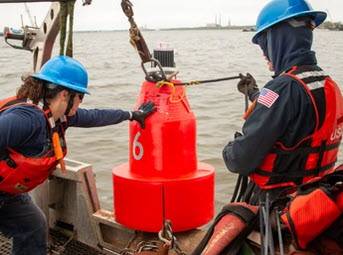Unified Command Reflects on Key Bridge Disaster Response Efforts
Approximately one month has passed since the Singaporean-flagged container vessel M/V Dali allided with the Francis Scott Key Bridge on March 26. The bridge, which connects Hawkins Point and Dundalk, Maryland, collapsed into the lower Patapsco River, bringing all maritime traffic in and out of the Port of Baltimore to a standstill.
The Unified Command offers its reflection on the response efforts underway:

During the incident involving the Dali, eight road crew workers, who were on break from repairing potholes, were present on the bridge when it collapsed. While two workers were rescued, four missing persons have been recovered, leaving two still unaccounted for. Despite the distressing circumstances, efforts to locate the missing workers continue, with utmost care and concern for the well-being of the families affected by this tragedy.
To date, 171 commercial vessels have transited the four alternate channels, including five of the vessels waiting to depart the Port of Baltimore since March 26.
137 containers of the estimated 180 necessary to access the portion of the bridge atop the Dali have been removed.
Presently, more than 350 uniformed and civilian workers from 53 federal, state, and local agencies across the U.S. are deployed to Baltimore for the ongoing recovery and salvage efforts. In addition, 553 contract specialists are actively involved in various roles related to dive, crane, and vessel operations. Over 1,000 individuals have contributed to the Key Bridge Response mission over the past month.
To address the estimated 50,000 tons of wreckage at the Francis Scott Key Bridge site, the Unified Command has assembled a substantial fleet of diverse vessels and equipment which includes 36 barges, 27 tugboats, 22 floating cranes, 10 excavators, one dredger, one skimmer, and three Coast Guard cutters. Progress in the salvage effort has been significant, with over 3,000 tons of wreckage and debris already removed from the site for disposal or recycling.
Ninety dive missions have been conducted by as many as seven dive teams, each consisting of four to five specialists. This tally does not include the numerous recovery-related dives undertaken within the initial 48 hours by over 60 divers from the Maryland State Police and other federal, state, and local agencies.
Survey vessels deployed by the Unified Command have executed more than 60 missions to gather sonar and laser imagery, essential for mapping the wreckage of the Dali and determining safe maritime navigation routes. This data, acquired day and night, is crucial for diver safety, enabling dive supervisors to guide underwater operations amidst the murky depths of the Patapsco River.
The National Oceanic and Atmospheric Administration’s Office of Coast Survey completed nine hydrographic survey assessments to help establish the temporary channels by identifying obstructions for salvage teams to remove. Following obstruction removal, the NOAA hydrographic survey team returned and verified the temporary alternate channels were clear and safe for vessel navigation.
Aerial efforts have also played a vital role, with more than 100 pilots and support specialists from over 35 agencies conducting 250 unmanned aircraft system missions and 60 manned helicopter and fixed-wing sorties. Serving as the literal eye-in-the-sky, the Air Operations branch has been instrumental from the early search and rescue phase to the ongoing salvage operations, providing essential oversight for Unified Command planners, operators, and leadership.
